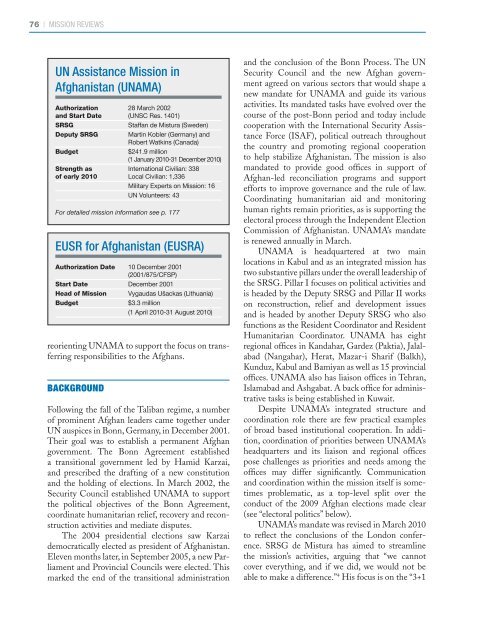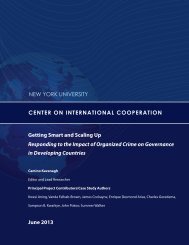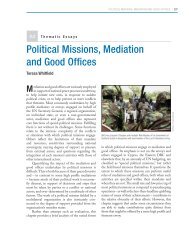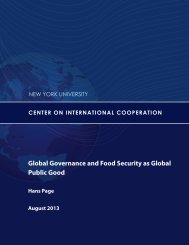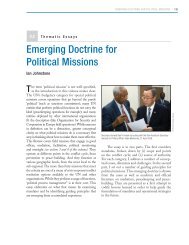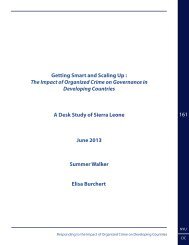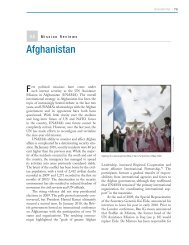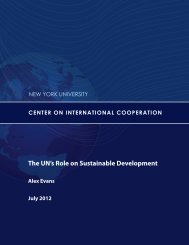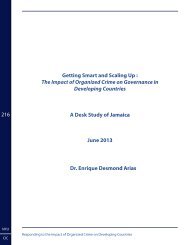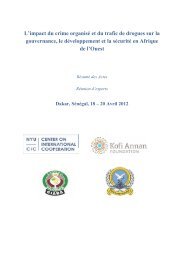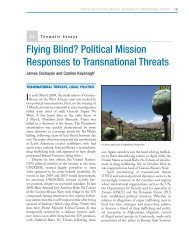here - Center on International Cooperation - New York University
here - Center on International Cooperation - New York University
here - Center on International Cooperation - New York University
Create successful ePaper yourself
Turn your PDF publications into a flip-book with our unique Google optimized e-Paper software.
76 | Missi<strong>on</strong> ReviewsUN Assistance Missi<strong>on</strong> inAfghanistan (UNAMA)Authorizati<strong>on</strong> 28 March 2002and Start Date (UNSC Res. 1401)SRSGStaffan de Mistura (Sweden)Deputy SRSG Martin Kobler (Germany) andRobert Watkins (Canada)Budget$241.9 milli<strong>on</strong>(1 January 2010-31 December 2010)Strength as Internati<strong>on</strong>al Civilian: 338of early 2010 Local Civilian: 1,336Military Experts <strong>on</strong> Missi<strong>on</strong>: 16UN Volunteers: 43For detailed missi<strong>on</strong> informati<strong>on</strong> see p. 177EUSR for Afghanistan (EUSRA)Authorizati<strong>on</strong> Date 10 December 2001(2001/875/CFSP)Start Date December 2001Head of Missi<strong>on</strong> Vygaudas Ušackas (Lithuania)Budget$3.3 milli<strong>on</strong>(1 April 2010-31 August 2010)reorienting UNAMA to support the focus <strong>on</strong> transferringresp<strong>on</strong>sibilities to the Afghans.BackgroundFollowing the fall of the Taliban regime, a numberof prominent Afghan leaders came together underUN auspices in B<strong>on</strong>n, Germany, in December 2001.Their goal was to establish a permanent Afghangovernment. The B<strong>on</strong>n Agreement establisheda transiti<strong>on</strong>al government led by Hamid Karzai,and prescribed the drafting of a new c<strong>on</strong>stituti<strong>on</strong>and the holding of electi<strong>on</strong>s. In March 2002, theSecurity Council established UNAMA to supportthe political objectives of the B<strong>on</strong>n Agreement,coordinate humanitarian relief, recovery and rec<strong>on</strong>structi<strong>on</strong>activities and mediate disputes.The 2004 presidential electi<strong>on</strong>s saw Karzaidemocratically elected as president of Afghanistan.Eleven m<strong>on</strong>ths later, in September 2005, a new Parliamentand Provincial Councils were elected. Thismarked the end of the transiti<strong>on</strong>al administrati<strong>on</strong>and the c<strong>on</strong>clusi<strong>on</strong> of the B<strong>on</strong>n Process. The UNSecurity Council and the new Afghan governmentagreed <strong>on</strong> various sectors that would shape anew mandate for UNAMA and guide its variousactivities. Its mandated tasks have evolved over thecourse of the post-B<strong>on</strong>n period and today includecooperati<strong>on</strong> with the Internati<strong>on</strong>al Security AssistanceForce (ISAF), political outreach throughoutthe country and promoting regi<strong>on</strong>al cooperati<strong>on</strong>to help stabilize Afghanistan. The missi<strong>on</strong> is alsomandated to provide good offices in support ofAfghan-led rec<strong>on</strong>ciliati<strong>on</strong> programs and supportefforts to improve governance and the rule of law.Coordinating humanitarian aid and m<strong>on</strong>itoringhuman rights remain priorities, as is supporting theelectoral process through the Independent Electi<strong>on</strong>Commissi<strong>on</strong> of Afghanistan. UNAMA’s mandateis renewed annually in March.UNAMA is headquartered at two mainlocati<strong>on</strong>s in Kabul and as an integrated missi<strong>on</strong> hastwo substantive pillars under the overall leadership ofthe SRSG. Pillar I focuses <strong>on</strong> political activities andis headed by the Deputy SRSG and Pillar II works<strong>on</strong> rec<strong>on</strong>structi<strong>on</strong>, relief and development issuesand is headed by another Deputy SRSG who alsofuncti<strong>on</strong>s as the Resident Coordinator and ResidentHumanitarian Coordinator. UNAMA has eightregi<strong>on</strong>al offices in Kandahar, Gardez (Paktia), Jalalabad(Nangahar), Herat, Mazar-i Sharif (Balkh),Kunduz, Kabul and Bamiyan as well as 15 provincialoffices. UNAMA also has liais<strong>on</strong> offices in Tehran,Islamabad and Ashgabat. A back office for administrativetasks is being established in Kuwait.Despite UNAMA’s integrated structure andcoordinati<strong>on</strong> role t<str<strong>on</strong>g>here</str<strong>on</strong>g> are few practical examplesof broad based instituti<strong>on</strong>al cooperati<strong>on</strong>. In additi<strong>on</strong>,coordinati<strong>on</strong> of priorities between UNAMA’sheadquarters and its liais<strong>on</strong> and regi<strong>on</strong>al officespose challenges as priorities and needs am<strong>on</strong>g theoffices may differ significantly. Communicati<strong>on</strong>and coordinati<strong>on</strong> within the missi<strong>on</strong> itself is sometimesproblematic, as a top-level split over thec<strong>on</strong>duct of the 2009 Afghan electi<strong>on</strong>s made clear(see “electoral politics” below).UNAMA’s mandate was revised in March 2010to reflect the c<strong>on</strong>clusi<strong>on</strong>s of the L<strong>on</strong>d<strong>on</strong> c<strong>on</strong>ference.SRSG de Mistura has aimed to streamlinethe missi<strong>on</strong>’s activities, arguing that “we cannotcover everything, and if we did, we would not beable to make a difference.” 4 His focus is <strong>on</strong> the “3+1


